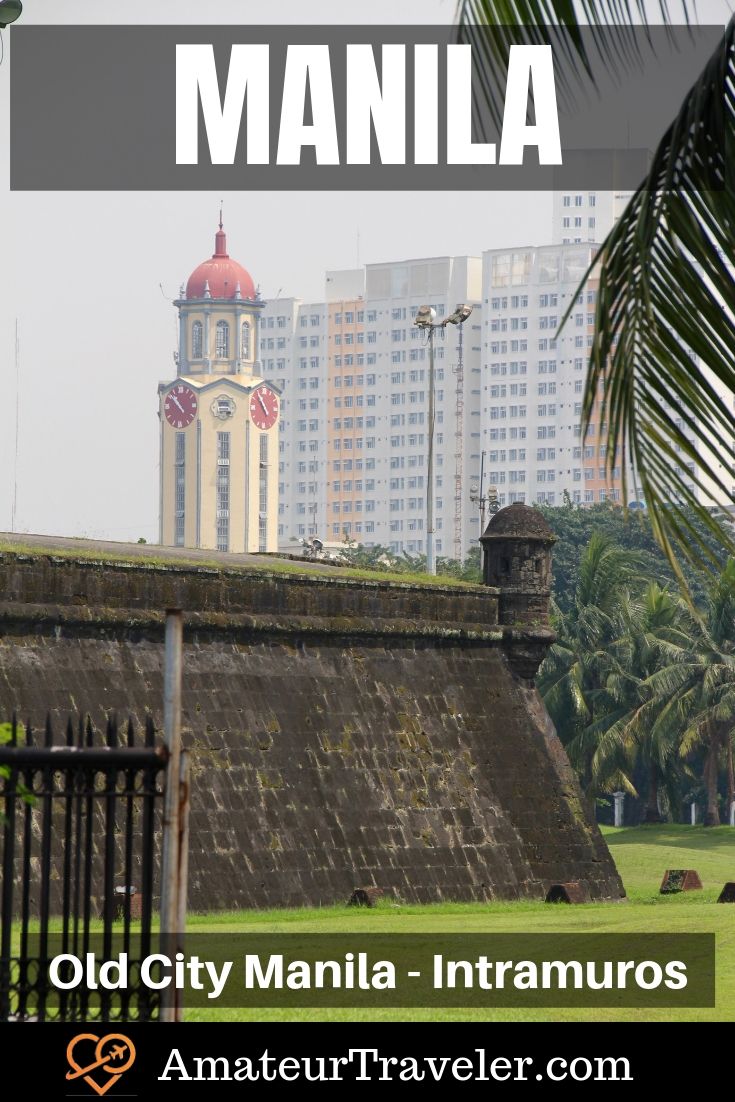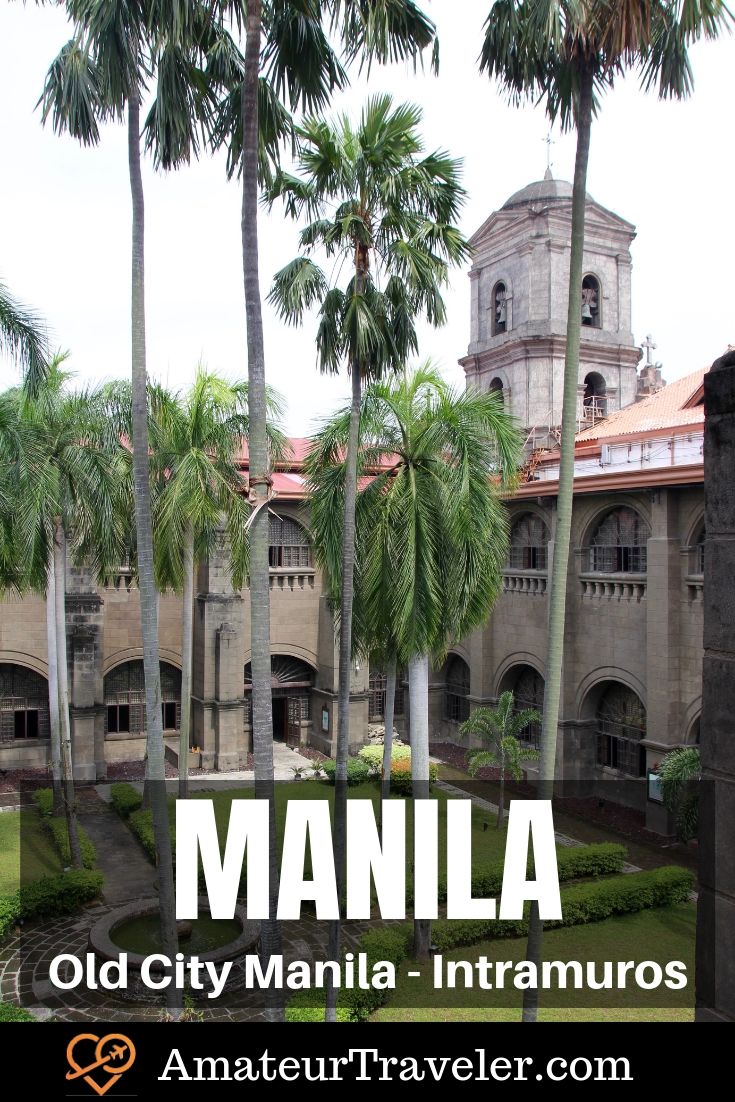The Old Walled City in Manila, Philippines – Exploring Intramuros (Video 86)
categories: asia travel, central america travel, pacific travel, south america travelManila is a sprawling city of 14 million people. It has challenging traffic and crowds. But within this modern city is still the old colonial walled city, the Intramuros. During the Spanish colonial period, this was the Spanish “Green Zone”. “Within the walls” or Intramuros was where those with Spanish blood lived while the natives lived outside the city walls, “extramuros”.
We traveled to the Intramuros neighborhood in a suped-up Jeepnee with air conditioning, bus seats and a karaoke machine complete with flat-screen display. Karaoke seemed appropriate since our tour guide John Elton was named after pop-star Elton John. He has a brother named John Lennon.
Table of contents: ()

right click here to download video (Small)
right click here to download video (Large)
Rizal Park
Our first stop was at the monument to national hero José Rizal at Rizal Park. Writer, nationalist, polyglot and ophthalmologist José Rizal helped spark the revolt against the Spanish with his novels, poems, and essays. Although not directly involved in the revolution the Spanish executed him on this spot for instigating it. When referring to Rizal, our guides simply call him THE National Hero and a stop at his monument is nearly mandatory.
For more information about Rizal visit the museum in nearby Fort Santiago where he was imprisoned. His last footsteps are commemorated in bronze on the ground there.
Rizal Park has continued to be a gathering point for major events in Madrid including protests or a mass during the 2015 visit by Pope Francis.
- Get a Car Rental
- Book Your Accommodation HERE
- Search for Great Tours HERE
- Buy Travel Insurance
- Get a universal plug adapter
- Get an eSim to be able to use your smartphone abroad.

Cathedral
Much of Manila in general and Intramuros specifically was destroyed in World War II. We started our tour of the city at the cathedral which is the heart of the city in this mostly catholic country. The cathedral has been built 8 different times since its foundations were laid in 1571. It has been destroyed by fire, earthquakes, and war.
The most recent version of Cathedral of the Immaculate Conception was completed in 1958.
Outside were horse-drawn carts and vendors selling straw hats while inside large groups were walking the stations of the cross in the various chapels.
Horse Drawn Cart
We boarded one of the horse-drawn carts for a stylish ride through the city. Manila is a bit humid for walking around for long periods of time so sitting in the shade while the horse did the walking, worked for me. Our driver told us that our horse was a retired racehorse.
Baluarte de San Diego
You can get up on the old Spanish walls of the city at the Baluarte de San Diego gardens. These thick walls date from 1587. The old guardhouses here are typical of Spanish construction and reminded me of El Moro in San Juan, Puerto Rico and other Spanish fortresses from the 16th century.
These walls kept out pirates but were breached by the British when they captured the city in 1762 during the Seven Years’ War. The walls were obsolete by the time of the Japanese conquest in 1942. U.S. And Filipino soldiers abandoned the city, declaring it an open city to spare the civilians. They then retreated to the more defensible Bataan Peninsula and Corregidor Island where they held out 3 more months before surrendering.
This area along with much of Intramuros was destroyed in the liberation of the Philippines in 1945. Intramuros remained in ruins until the 1980s but now the Baluarte de San Diego is surrounded by gardens and sees more weddings than invasions.
Casa Manila
We visited the Casa Manila which is a reconstruction of the home of one of the wealthy families that lived in the Intramuros. The house is a reconstruction but the items in the home are originals. A home like this boasted goods from all over the world. Much of the artwork was from china, the woodcarving from the Philippines and the piano from the U.S. The family private chapel was painted in the style of a Gothic Cathedral. The second floor is surrounded by windows that can be opened to let in a breeze. Or the windows can be closed to the breeze but let in light through translucent sea shells window panes.
Life inside the walls was good. During the Spanish period, education and opportunity were only available to those with Spanish blood. While the American colonization started with a bitter war, the Americans introduced public education which is why so much English is found in the Philippines and so little Spanish despite the much longer Spanish presence.
Casa Manila is definitely worth a visit, but no pictures are allowed.
San Agustin Church
Of the 7 churches inside the city walls, only one of the old churches from the colonial period survived WWII. That church, San Agustin Church, is now a UNESCO World Heritage site. The church was finished in 1607.
Take the time to explore the attached museum which chronicles the history of the Augustinian monks who brought Christianity to the Philippines. Look for the picture of the earthquake damage that the church sustained in the 1800s and for the collection of ivory used for faces and hands of religious figurines.
Conclusion
The Intramuros was my favorite part of Manila. It is worth a visit, and if you throw in a kaoroka Jeepnee, what’s not to love.
+Chris Christensen | @chris2x | facebook
Leave a Reply
Tags: article, manila, philippines, video travel podcast









 Things To Do in Manila Philippines – History, Shopping, Sunsets and Day Trips
Things To Do in Manila Philippines – History, Shopping, Sunsets and Day Trips A Love Affair with Jeepneys – Rice Terraces of the Cordillera, Philippines (Video #87)
A Love Affair with Jeepneys – Rice Terraces of the Cordillera, Philippines (Video #87) Travel to the Philippines – Episode 201
Travel to the Philippines – Episode 201 Batad Rice Terraces – The Philippines
Batad Rice Terraces – The Philippines
